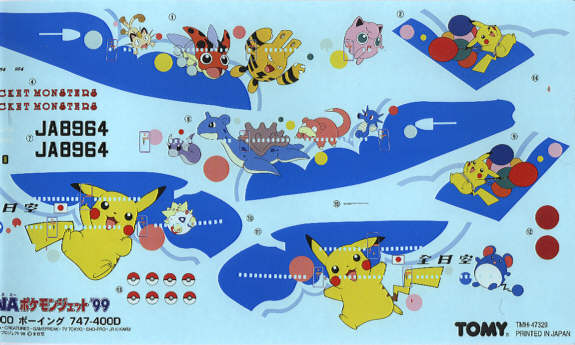| DECALS |

The decal is so big I couldn't fit it onto my
scanner. The cut-off seen on the left edge is NOT a decal
fault.
| KIT: | Tomy 1/200 scale 747-400D "Pokemon '99" |
| KIT # | TMH-47329 |
| PRICE: | Y2000 (approximately US$19.50) |
| DECALS: | All Nippon Airways (ANA) Pokemon 1999 special livery |
| REVIEW & PHOTOS BY: | Andrew Abshier, Oklahoma Historical Modelers Society (OHMS) |
| NOTES: | Kit available only in Japan |

| HISTORY |
Arguably the most recognizable airliner in the world after the Concorde, the Boeing 747 first flew in 1968. Nearly 1000 examples of the "classic" 747 were built from 1968 up to 1988. In 1987 a new variant, the 747-400, was introduced. It differed from the classic 747s in having an extended upper deck, redesigned wings with winglets, and new, more powerful engines. A number of internal changes were undertaken with the 747-400 to increase the type's range; intercontinental versions can fly over 7,000 miles nonstop with a full load.
In response to requests from long-standing 747 customers Japan Air Lines and All Nippon Airways, Boeing developed the 747-400D (domestic). This retained all of the changes of the 747-400 with the addition of strengthened landing gear and conventional wingtips. These aircraft are employed on high-frequency, high-density routes within Japan--think Southwest Airlines but with 550 seats instead of 130! 747-400Ds can be converted back into conventional 747-400 intercontinental, and this will be eventually be done to all 747-400Ds currently in service to minimize cycle times and extend airframe life.
Pokemon (Pocket Monsters) need no introduction to most of our readers here
(especially those with small children). As much of a craze as it is in the
United States, it is nothing compared to the popularity of Pokemon in
Japan! In 1999 All Nippon Airways rolled out two aircraft painted in a
special Pokemon livery: a 747-400D and, to appease the children living in
smaller markets, a 767-300.
|
THE KIT |
While marketed by Tomy, the plastic inside this kit is by Hasegawa. It represents a 747-400D with General Electric CF-6 engines. The fuselage halves are molded in white, and all other parts are molded in gray. This was probably done to give the kit a more finished look to those who choose not to paint their model.
Overall outline is very accurate. Hasegawa did especially well in capturing the windshield outline, which has been missed by other manufacturers. Surface detail is entirely raised with the exception of engraved control surfaces, flaps, and both cargo and passenger doors. The raised detail is very finely done and represents the major panel lines.
No interior detail is provided at all, but in this small scale it is hardly necessary. It would have been nice if the wheel wells had been boxed in, but fortunately with the square main gear bays it is not a hard fix. Note that if you build the fuselage with clear cabin windows, you'll need to put some sheet plastic floors in to block the view between the cockpit and the lower passenger deck. Hasegawa does provide a fuselage bulkhead and nose weights, so there are no worries about this model sitting properly when finished.
Landing gear is simplified but acceptable. Wheels and wheel hubs are nicely done. As mentioned, there is no detail in the wheel wells, and there is no detail inside of the wheel doors either.
Engines consist of four parts: the cold stream cowling/strut halves, hot stream exhaust, and fan. No intake trunking is provided between the fan and the intake lip. Enterprising modelers might be able to do one by using brass tubing, but even a stock 747 engine in this scale comes out looking nice.
While I've not built the 747-400, I have built other Hasegawa 747s.
Generally component fit is very good, and that includes critical areas like
wing-to-fuselage fit, which is very positive and solid. With some care in
assembly and a few extra details on the engines and landing gear, a very nice
747 model should result.
| DECALS |

The decal is so big I couldn't fit it onto my
scanner. The cut-off seen on the left edge is NOT a decal
fault.
The enormous decal sheet--12 by 7 inches--covers most of the bottom of the
box. All of the Pokemon characters are superbly rendered and perfectly in
register. Applying these decals will require the maximum in decal
application skills, though. All of the blue parts of the fuselage are
given on the decal sheet, and these areas cover highly complex curves such as
the tail cone and windshield area. In addition, the windshield and windows
are given as "drop outs" on the decals, which means some very fancy alignment
will be needed to get the decals in place. When I build mine, I plan on
filling in the cabin windows with resin and using decal windows. This
should make life a little easier on the decal application. I would also recommend
that the blue areas be underpainted with a closely matching blue
paint, so that any decal chipping will not be as obvious.
|
CONCLUSIONS |
It's nice to see the Japanese let their hair down, so to speak, on their airline liveries, after years of having very stiff and formal airline liveries. The Pokemon characters combined with a good base 747-400D model should make this a fun project.
These kits are available only in Japan, and the box is labeled as
such. Hobbylink Japan is the obvious source to use, but it might be
available from the airline specialist outlets soon also.